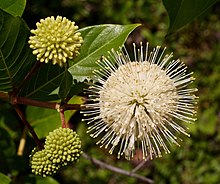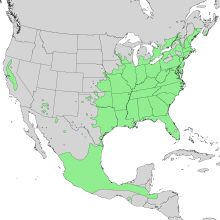Cephalanthus occidentalis
| Buttonbush | |
|---|---|
 |
|
| C. o. var. occidentalis | |
| Scientific classification | |
| Kingdom: | Plantae |
| (unranked): | Angiosperms |
| (unranked): | Eudicots |
| (unranked): | Asterids |
| Order: | Gentianales |
| Family: | Rubiaceae |
| Subfamily: | Cinchonoideae |
| Tribe: | Naucleeae |
| Genus: | Cephalanthus |
| Species: | C. occidentalis |
| Binomial name | |
|
Cephalanthus occidentalis L., 1753 |
|
| Varieties | |
|
C. o. var. californicus |
|
 |
|
| Natural range of Cephalanthus occidentalis | |
C. o. var. californicus
C. o. var. occidentalis
Cephalanthus occidentalis is a species of flowering plant in the coffee family, Rubiaceae, that is native to eastern and southern North America. Common names include buttonbush, common buttonbush, button-willow and honey-bells.
C. occidentalis is a deciduous shrub or small tree that averages 1–3 m (3.3–9.8 ft) in height, but can reach 6 m (20 ft). The leaves are opposite or in whorls of three, elliptic to ovate, 7–18 cm (2.8–7.1 in) long and 4–10 cm (1.6–3.9 in) broad, with a smooth edge and a short petiole. The flowers are arranged in a dense spherical inflorescence 2–3.5 cm (0.79–1.38 in) in diameter on a short peduncle. Each flower has a fused white to pale yellow four-lobed corolla forming a long slender tube connecting to the sepals. The stigma protrudes slightly from the corolla. The fruit is a spherical cluster of achenes (nutlets).
There are two varieties, not considered distinct by all authorities:
Buttonbush is a common shrub of many wetland habitats in its range, including swamps, floodplains, mangrove, pocosin, riparian zones, and moist forest understory. It is a member of the flora in the Everglades.
...
Wikipedia
